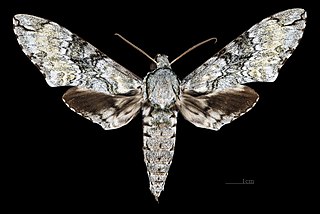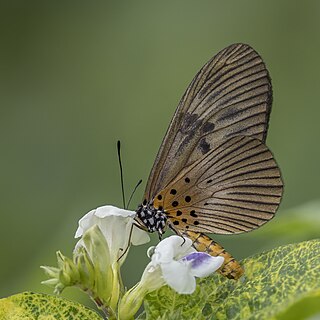
Manduca is a genus of moths in the family Sphingidae, the hawkmoths. The genus is used as a model in the biological sciences. The tobacco hornworm and the tomato hornworm in particular have been well studied. The genus was erected by Jacob Hübner in 1807.

Colotis vestalis, the white Arab, is a small butterfly of the family Pieridae, that is, the yellows and whites, which is found in India, Pakistan, Iran, Somalia, Ethiopia, Sudan, Kenya and Tanzania. It has a wingspan of 4–5 cm.

Cuckoo bumblebees are members of the subgenus Psithyrus in the bumblebee genus Bombus. Until recently, the 28 species of Psithyrus were considered to constitute a separate genus. They are a specialized socially parasitic lineage which parasitises the nests of 'true' bumblebees, resulting in the loss of the ability to collect pollen and establish their own nests. Cuckoo bumblebees do not create a worker caste and produce only male and female reproductives. They are considered inquilines in the colonies of 'true' bumblebees.

Bombus vestalis, the vestal cuckoo bumblebee, is a species of cuckoo bumblebee that lives in most of Europe, as well as North Africa and western Asia. It is a brood parasite that takes over the nests of other bee species. Its primary host is Bombus terrestris. After its initial classification as Psithyrus vestalis, this bumblebee recently was reclassified into the genus Bombus, subgenus Psithyrus.
Epimetasia is a genus of moths of the family Crambidae.

Lestes virens is a species of damselfly in the family Lestidae, the spreadwings. It is known commonly as the small spreadwing or small emerald spreadwing. It is native to much of Europe and western and central Asia.

Vestalis is a genus of damselflies belonging to the family Calopterygidae.

Vestalis gracilis, is a species of damselfly belonging to the family Calopterygidae. It is known commonly as the clear-winged forest glory or clear-winged flash-wing. It is native to Southeast Asia and surrounding regions.

Manduca vestalis is a moth of the family Sphingidae. It is found from Brazil to Venezuela and probably north-western Bolivia.

Eublemma vestalis is a species of moth of the family Erebidae first described by Arthur Gardiner Butler in 1886. It is found in Queensland in Australia.
Cotesia vestalis is a parasitoid wasp that appears to be able to detect volatile organic compounds emitted by the plant Brassica oleracea in response to herbivore damage, such as would be caused by heavy infestation with the wasp's host caterpillar Plutella xylostella.

Bematistes vestalis, the smoky bematistes, is a butterfly in the family Nymphalidae. It is found in Senegal, Guinea, Burkina Faso, Sierra Leone, Liberia, Ivory Coast, Ghana, Togo, Nigeria, Cameroon, Gabon, the Republic of the Congo, the Democratic Republic of the Congo and Tanzania.

Somatina vestalis is a moth of the family Geometridae. It is found in Kenya, Malawi, Mozambique, South Africa, Zambia and Zimbabwe.

Vestalis apicalis, or the black-tipped forest glory, is a species of damselfly belonging to the family Calopterygidae. It is found in India and Sri Lanka.

Spilosoma vestalis, the Vestal tiger-moth, is a moth in the family Erebidae. It was described by Alpheus Spring Packard in 1864. It is found along the coast of western North America, from California north to the Kitsap Peninsula in Washington and western Idaho.
Epimetasia gregori is a moth in the family Crambidae. It was described by Hans Georg Amsel in 1970. It is found in Afghanistan.
Epimetasia monotona is a moth in the family Crambidae. It was described by Hans Georg Amsel in 1953. It is found in Mauritania.

Vestalis submontana is a species of damselfly belonging to the family Calopterygidae. It is principally found in the Western Ghats of India, with some records further east.













